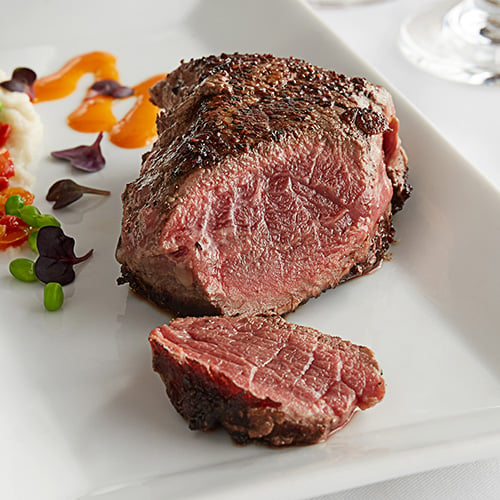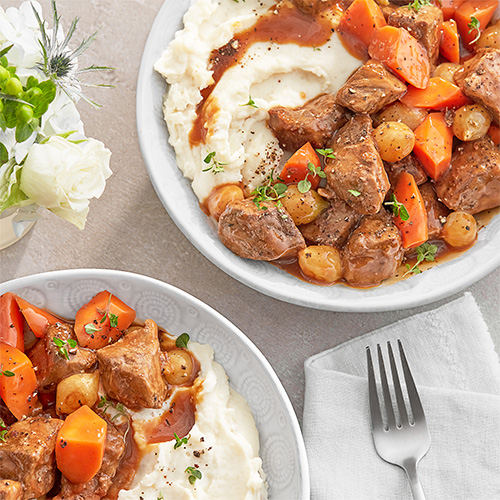Protein is typically the foundational piece of a catered meal, with the sides and hors d'oeuvres serving as accent notes. Given its centrality, caterers must calculate protein prep quantities based on the overall headcount and style of event. This will ensure that you don't run out of food or end up with waste. Whether you're starting a catering business or revamping your menu, we walk you through how much meat you will need per person, broken out by protein type, so you can protect your profits and plan accordingly.
How Much Meat to Serve Per Person for Catering?

The amount of meat you should serve can vary based on the type of event and the time of day. Keep in mind that these serving sizes are general guidelines and can be adjusted based on the specific preferences of your guests and the overall event menu.
- Breakfast Protein Portion: For a breakfast or brunch event, consider serving around 4-6 ounces of meat per person. This can include popular breakfast options such as bacon, sausage links, or ham slices. These breakfast meats are typically served in smaller portions compared to lunch or dinner events.
- Lunch Protein Portion: For a lunch event, increase the portion size to around 6-8 ounces of meat per person. This can include options like sliced turkey, roast beef, or grilled chicken. Lunch portions should be hearty enough to satisfy guests without being overly filling.
- Dinner Protein Portion: For a dinner event, aim to serve around 8-12 ounces of meat per person. This can include options like prime rib, pork tenderloin, or salmon fillets. Dinner portions are typically larger to accommodate a more substantial meal experience for guests.
Ounces of Meat Per Person by Event Type
When planning a catering event or menu, determining the appropriate amount of protein to serve per person is crucial for ensuring guest satisfaction and cost-effectiveness. The following detailed breakdown provides a guide on how many ounces of meat per person for various types of events.
- Weddings and Formal Events: For catered weddings and formal events where a full meal is served, it is recommended to allocate approximately 8-10 ounces of meat per person. This amount allows for a generous portion size, ensuring guests are satisfied with the main course.
- Casual Gatherings and Buffets: For casual gatherings, buffets, or events with multiple protein options, plan for around 6-8 ounces of meat per person. This quantity provides variety for guests to choose from while still offering a substantial portion size.
- Barbecues and Outdoor Events: When hosting a barbecue or outdoor event, consider serving approximately one pound of meat per person. This quantity accounts for the casual nature of the event and the likelihood that guests may want to sample a variety of meats.
- Corporate Functions and Business Meetings: For corporate functions or business meetings where a lighter meal is served, aim for 4-6 ounces of meat per person. This amount strikes a balance between providing a satisfying meal without creating excess leftovers.
- Holiday Feasts and Celebrations: During holiday feasts or celebratory events, plan for a larger portion size of around 10-12 ounces of meat per person. Holidays often call for indulgent meals, and this quantity ensures that guests can enjoy a hearty main course.
How Much Steak Per Person?

The amount of steak per person can vary depending on the cut of steak, the cooking method, and individual preferences. We provide guidelines to help you determine how much steak to serve per person, but make adjustments based on your guests' appetites and the other dishes being served.
- Filet Mignon: Considered one of the best cuts of steak, filet mignon is tender and flavorful. It is typically served in smaller portions due to its richness. A standard serving size for filet mignon is around 6 to 8 ounces per person.
- Ribeye Steak: Ribeye steak is known for its rich marbling and intense flavor. A typical serving size for ribeye steak is around 10 to 12 ounces per person.
- New York Strip Steak: Known for its balance of tenderness and flavor, New York strip steak is a popular choice. A standard serving size for New York strip steak is around 8 to 10 ounces per person.
- T-Bone Steak: As a larger beef cut, T-bone steak includes both the tenderloin and the strip steak. A typical serving size for T-bone steak is around 12 to 16 ounces per person. This higher ounce portion compared to other cuts is because the T-bone cut includes the actual bone, driving up its weight.
- Sirloin Steak: A versatile and affordable cut of steak, sirloin steak is great for grilling. A standard serving size for sirloin steak is around 8 to 10 ounces per person.
- Flank Steak: Flank steak is a lean and flavorful cut of steak that is best served thinly sliced. A typical serving size for flank steak is around 6 to 8 ounces per person.
- Skirt Steak: As a thin steak cut, skirt steak is perfect for marinating and grilling. A standard serving size for skirt steak is around 6 to 8 ounces per person.
How Much Beef Per Person?

When planning a buffet or catering event where guests may serve themselves, it's recommended to provide a variety of beef cuts to accommodate different preferences. Whether you are serving roasts, ground beef, brisket, or short ribs, knowing the appropriate portion sizes can help you manage costs and maintain consistency in your dishes.
- Roasts: When serving beef roasts, a general rule of thumb is to allocate about 8-12 ounces of cooked meat per person. This amount allows for a hearty serving that can satisfy most appetites. The actual weight of the raw roast will be higher due to moisture loss during cooking.
- Ground Beef: Used in various dishes such as burgers, meatloaf, and pasta sauces, ground beef is a versatile ingredient. For main dishes like burgers, plan for approximately 6-8 ounces of ground beef per burger patty. When preparing dishes like meatloaf or pasta sauces, allocate around 4-6 ounces of cooked ground beef per person.
- Brisket: A popular meat for smoking, brisket is known for its rich flavor and tenderness when cooked properly. When serving brisket, aim for about 6-8 ounces of cooked meat per person. This amount allows for a generous portion that highlights the unique texture and taste of this cut.
- Short Ribs: Short ribs are a flavorful and succulent cut of beef that can elevate any menu. When serving short ribs, plan for approximately 6-8 ounces of cooked meat per person. This portion size ensures that diners can enjoy the rich taste and tender texture of the meat.
How Much Chicken Per Person?

Different cuts of chicken have varying portion sizes, so it's crucial to have a clear understanding of the quantities needed. Proper portion control not only helps prevent food waste but also ensures customer satisfaction by delivering consistent serving sizes. Here is a guide to help you determine how much chicken to serve per person:
- Chicken Breasts: Thanks to their lean protein content, chicken breasts are a popular and versatile choice. On average, a boneless, skinless chicken breast weighs about 6 to 8 ounces. When serving chicken breasts as a main course, plan for one whole chicken breast per person. If you are serving sliced or diced chicken breasts in a dish, you can account for slightly less per person, around 4 to 6 ounces.
- Chicken Thighs: Chicken thighs are known for their rich flavor and tenderness. A bone-in, skin-on chicken thigh typically weighs around 4 to 6 ounces. When serving chicken thighs as a main course, plan for one to two thighs per person, depending on the size of the thighs and the appetite of your customers.
- Chicken Wings: Bone-in and boneless chicken wings are a popular appetizer or snack option. On average, a single chicken wing weighs about 2-3 ounces. When serving chicken wings, plan for around 6 to 8 wings per person for a main course or 3 to 5 wings per person for an appetizer portion.
How Much Pork Per Person?

From BBQ staples like ribs and pulled pork to pork chops and ham, pork cuts lend themselves to a variety of cuisines. Here's a breakdown of how much pork to serve per person for various popular pork dishes:
- Ribs: When serving pork ribs, a good rule of thumb is to allocate around 8 to 16 ounces of ribs to account for the bones' weight. This can vary based on the type of ribs and whether they are served as an appetizer or main course.
- Pulled Pork: Versatile pulled pork can be served in sandwiches, tacos, or as a main course. Plan on serving approximately 5 to 8 ounces of pulled pork per person, depending on the serving style and accompanying dishes.
- Pork Chops: Whether smothered, grilled, or pan-fried, pork chops are a classic choice for a hearty meal. For bone-in pork chops, aim for around 1 chop per person. If serving boneless pork chops, plan on 1 to 2 chops per person, depending on the size and thickness of the chops.
- Pork Loin: This lean and flavorful pork cut can be roasted, grilled, or braised. Allocate approximately 4 to 5 ounces of pork loin per person for a satisfying portion.
- Pork Shank: Perfect for braising or slow-cooking, pork shank is a rich and succulent cut. Plan on serving around 8 to 12 ounces of pork shank per person for a hearty meal.
- Ham: Whether serving ham as a holiday centerpiece or ham cuts as part of a sandwich platter, it's essential to portion it correctly. For bone-in ham, allocate about 5 to 8 ounces per person. For boneless ham, plan on serving 4 to 5 ounces per person.
- Pork Belly: Prized for its rich flavor and crispy skin when cooked properly, pork belly is a decadent cut, so a little goes a long way. When serving pork belly, aim for around 4 to 5 ounces per person since much of the piece will be fat.
How Much Seafood Per Person?

When planning a seafood menu for your commercial kitchen, it's essential to understand the recommended protein portions per person to ensure customer satisfaction and cost-effectiveness. Here is a guide to help you determine how much seafood to serve per person:
- Shrimp: Typically served as an appetizer or main course, shrimp is a popular seafood choice. A standard portion size for shrimp is around 4 to 6 ounces per person.
- Salmon: Versatile salmon can be served in various dishes, such as grilled fillets or smoked salmon platters. A typical serving size for salmon is approximately 6 to 8 ounces per person.
- Mahi Mahi: Also known as dolphinfish, mahi mahi is a flavorful white fish that is often grilled or pan-seared. The recommended portion size for mahi mahi is about 6 to 8 ounces per person.
- Swordfish: Ideal for grilling or broiling, swordfish is a meaty fish with a firm texture. A standard serving size for swordfish is around 6 to 8 ounces per person.
- Calamari: Calamari, a.k.a squid, is a popular appetizer choice that is typically served fried or grilled. The recommended portion size for calamari is approximately 4 to 6 ounces per person.
- Crab Legs: Typically served as a main course or on seafood towers, crab legs are a favorite seafood choice. The recommended portion size for crab legs is approximately 16 to 24 ounces per person since most of this weight will be the shell.
- Oysters: Considered a delicacy, oysters can be served raw on the half shell or cooked in various dishes. The standard serving size for oysters is around 6 to 12 oysters per person.
- Sashimi: A popular Japanese dish, sashimi consists of thinly sliced raw fish that is typically served as an appetizer or part of a sushi platter. The recommended portion size for sashimi is about 2 to 4 ounces per person.
How Much Vegan Protein Per Person?

Below is a guide on how much vegan protein to serve per person at a catered event when vegan protein sources are the main contributor of protein for the meal. Get a headcount of how many vegans/vegetarians will be in attendance so you can plan accordingly. If you want to have an additional vegan option available to everyone in addition to an animal protein, account for 2-3 ounces per person of the total headcount
- Beyond Meat: A popular plant-based meat substitute, Beyond Meat provides a substantial amount of protein. When serving Beyond Meat at a catered event, plan to offer the same quantity of the plant-based meat substitute as you would its animal-based counterpart.
- Lentils: High in both protein and fiber, lentils are nutrient-dense legumes. When incorporating lentils into your catered menu, plan to serve around 1/2 to 1 cup of cooked lentils per person to provide a hearty and protein-packed dish.
- Tofu: Versatile tofu is a protein-rich vegan ingredient that can be used in a variety of dishes. For a catered event, aim to serve approximately 4-6 ounces of tofu per person to provide a substantial amount of protein for vegan guests.
- Beans: A staple in vegan cuisine, beans are an excellent source of plant-based protein. When serving beans at a catered event, aim to offer approximately 1/2 to 1 cup of cooked beans per person to ensure that guests receive an ample amount of protein.
As caterers, it is essential to plan so you have the right amount of protein for your events. By following a protein portion guide, you can accurately estimate the amount of meat needed for each guest, reducing waste and saving costs. Proper portioning also helps maintain consistency in your dishes for superior quality and quantity.



